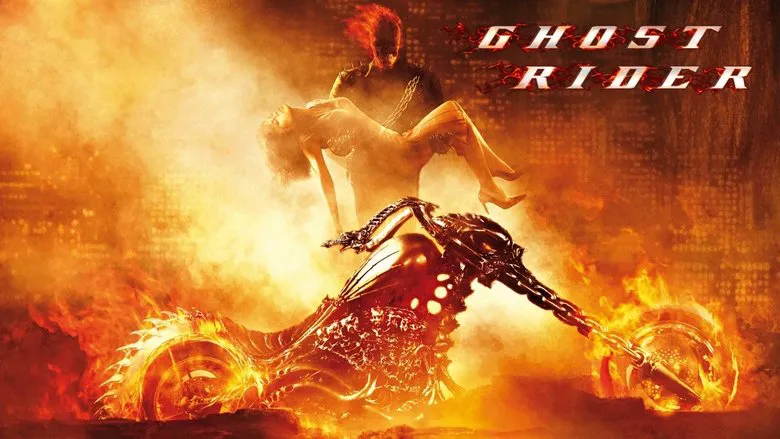Ghost Rider: A Blaze of Infernal Grandeur
While “Ghost Rider,” helmed by comic book aficionado Mark Steven Johnson (also known for 2003’s “Daredevil”) and adapted from the legendary Marvel comic series, might not stake its claim as the cinematic masterpiece of the year or solidify itself as an enduring classic within the superhero genre, it undoubtedly delivers an unparalleled spectacle for the price of admission. It’s an unapologetic, larger-than-life visual feast. Picture this: a leather-clad entity, astride a custom “Harley” that seems to be a self-propelling skeleton of some prehistoric, infernally-charged mollusk, its head a literal blazing skull – if that’s not inherently, utterly awesome, what is?
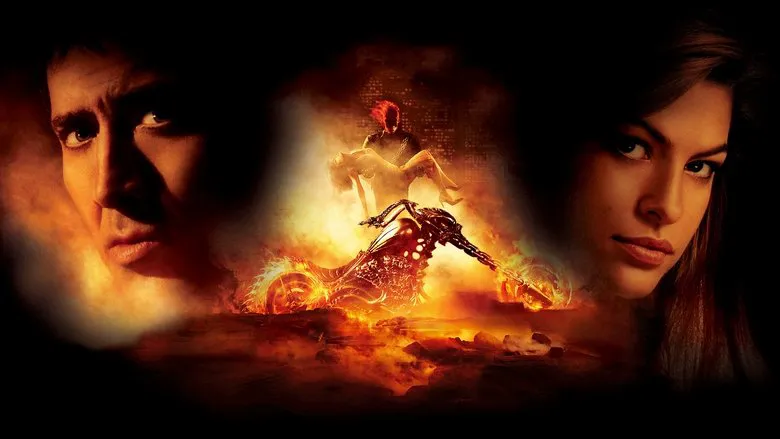
A Deal Forged in Fire and Fate
The narrative delves into the tragic origins of Johnny Blaze, a prodigious stunt performer following in the footsteps of his equally daring father. Blaze Sr. was a legend, renowned for executing the most complex and death-defying motorcycle stunts, soaring over football fields brimming with obstacles, and emerging unscathed from fiery explosions – feats that captivated audiences worldwide. However, a hidden adversary, a virulent cancer, was silently consuming his father, sealing his fate. It was amidst this despair that a mysterious, black-cloaked figure emerged before young Johnny. This was Mephistopheles (portrayed with chilling gravitas by Peter Fonda), who offered a Faustian bargain: his father’s cure in exchange for Johnny’s immortal soul. Without significant hesitation, Johnny agreed.
The next morning brought a fleeting moment of joy as his father jubilantly announced that doctors found no trace of the disease during a routine check-up. Yet, typical of such demonic pacts, the cure was bittersweet and tragically temporary. Hours later, Blaze Sr. perished in a literally death-defying stunt, his life extinguished just as his health seemed restored. The terms of the dark agreement, however, remained binding. Years later, as is customary with the Prince of Darkness, the time for collection arrived. Mephistopheles resurfaced, compelling Johnny to fulfill his past, rash promise.
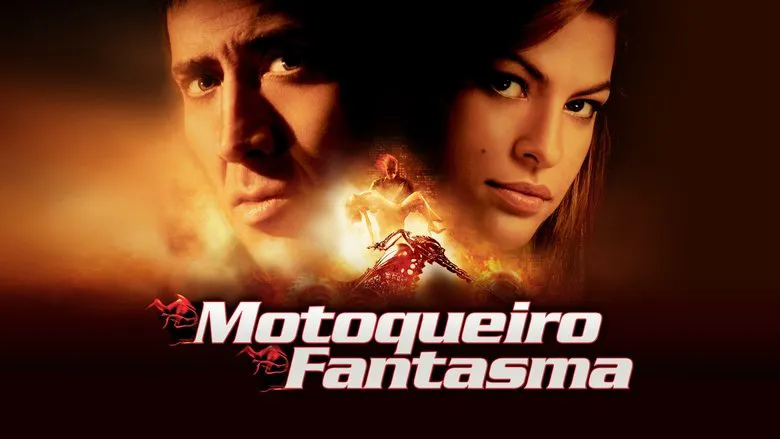
Now, under the cloak of night, Johnny Blaze undergoes a horrifying metamorphosis. He ceases to be human; his flesh incinerates, his head transforms into a vengeful, flaming skull, and he becomes the Ghost Rider – a dark mercenary bound to Mephistopheles’ will, yet somehow dispensing a twisted form of justice along his path. Mephistopheles’ primary objective for the Rider is to confront and subdue Blackheart (Wes Bentley), the malevolent son of the lord of darkness, who plots to usurp his father’s domain and unleash absolute pandemonium upon Earth.
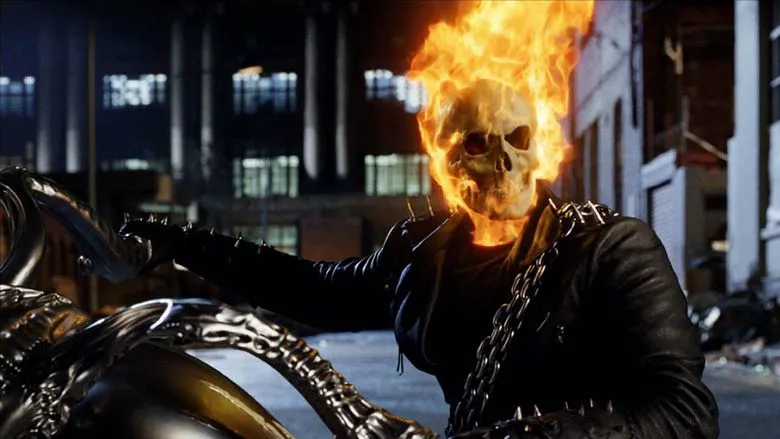
The Irresistible Allure of a Guilty Pleasure
For the entirety of its ninety-minute runtime, “Ghost Rider” often sparks an amusing internal debate: the realization of how fortunate one is to have matured past the impressionable age of fourteen (lest the movie’s impact prove unpredictable), yet concurrently, a yearning for that very age. Because, let’s be absolutely clear, the image of a creature garbed in leather, riding a “Harley” resembling a self-propelled prehistoric skeleton-mollusk, crowned with a flaming skull, remains undeniably, uncannily awesome.
The overall experience is akin to chugging a few cans of highly caffeinated, perhaps not-so-healthy, but undeniably energizing beverages, while settling in to gaze upon the most iconic album covers from the golden era of the New Wave of British Heavy Metal. Think Iron Maiden, whose recurring skeletal mascot, Eddie, epitomizes the very spirit of the film’s visual bravado. The special effects are not just lavish and abundant; they revel in their own artificiality. They make no pretense of being subtly realistic. Instead, they proudly exist as glorious, over-the-top visual effects, purely designed to delight the eye with their brazen spectacle.
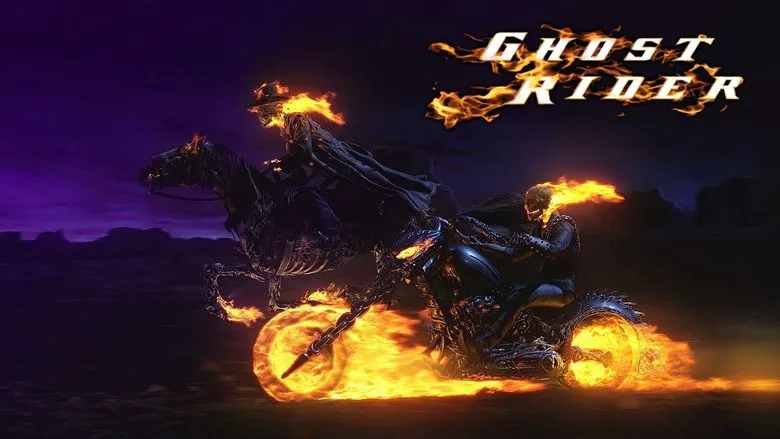
While the narrative itself is certainly far from flawless, often treading familiar ground and evoking a pervasive sense of déjà vu, it’s remarkably easy to overlook its shortcomings. When the Ghost Rider unleashes his lethal, flaming chain, or hurls a catastrophic fireball from his palm, plot inconsistencies simply melt away like ice in the desert. In those moments of pure, unadulterated comic book action, all you want to do is cheer and applaud with unbridled enthusiasm.
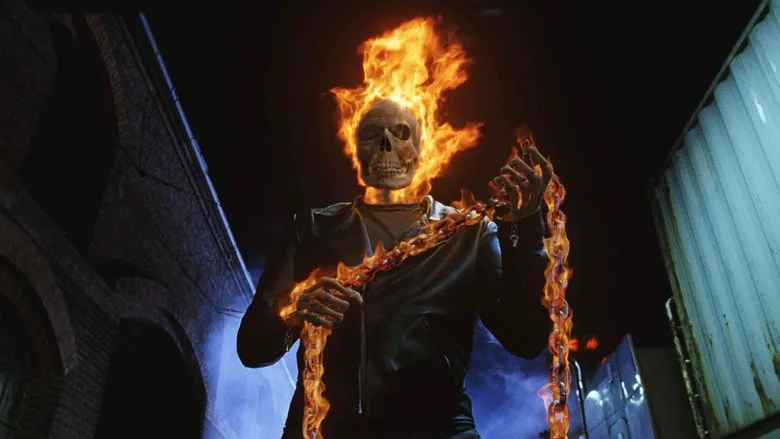
Nicolas Cage: Finding Redemption in a Blazing Skull
Perhaps the most surprising triumph of “Ghost Rider” lies in the unlikely artistic renaissance of Nicolas Cage in the role of Johnny Blaze. Following his utterly misjudged performances in films like “World Trade Center” (2006) and, more dramatically, his much-maligned turn in the remake of “The Wicker Man” (2006), it seemed his reputation as a compelling actor was irrevocably tarnished. Yet, here, Cage manages to remain remarkably uninvolving in the negative sense – primarily because for the greater part of the action, he literally has no face. The transformation into the flaming-skulled Ghost Rider deprives the actor of the opportunity to showcase the truly boundless, albeit sometimes peculiar, potential of his distinctive facial expressions.
One can hardly avoid the wry observation: if Nicolas Cage’s face were to inexplicably burst into a flaming skull in all his other cinematic endeavors, his unique presence might just become invaluable. In “Ghost Rider,” this narrative device proves to be his unexpected saving grace, channeling his distinctive energy into a role that perfectly leverages its titular, blazing spectacle. It allows us to appreciate him for moments of sincere, perhaps even endearing, oddball commitment without the often-polarizing facial theatrics that have defined much of his later career.
